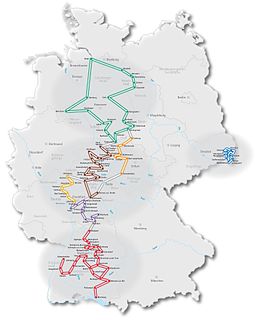Kaiser Wilhelm Tower or Emperor William Tower is the name of various observation towers, mostly in Germany, which are given that name, although some of them also have alternative names:
Extant Kaiser Wilhelm towers in Germany:
Non-preserved Kaiser Wilhelm towers:
Kaiser Wilhelm towers that have since been renamed or rededicated:
Falkenstein or Falckenstein may refer to:
Fürstenberg may refer to:
The German football league system, or league pyramid, refers to the hierarchically interconnected league system for association football in Germany that in the 2016–17 season consists of 2,235 leagues in up to 13 levels having 31,645 teams, in which all divisions are bound together by the principle of promotion and relegation. The top three professional levels contain one division each. Below this, the semi-professional and amateur levels have progressively more parallel divisions, which each cover progressively smaller geographic areas. Teams that finish at the top of their division at the end of each season can rise higher in the pyramid, while those that finish at the bottom find themselves sinking further down. Therefore, in theory, it is possible for even the lowest local amateur club to rise to the top of the system and become German football champions one day. The number of teams promoted and relegated between the divisions varies, and promotion to the upper levels of the pyramid is usually contingent on meeting additional criteria, especially concerning appropriate facilities and finances.
The Landesliga is a tier of football in some states of the German football league system.
This is a list of coats of arms of Germany.
Germany's federal system comprises 16 state parliaments, each including directly elected representatives.
The Rugby Regionalliga is the third-highest level of Germany's Rugby union league system, organised by the German Rugby Federation. Its set below the 2nd Rugby-Bundesliga. It is organised in eight regional divisions.
The Länderpokal is the oldest cup competition of the German Football Association. It came into existence as the Kronprinzenpokal but has changed its name various times since. The cup is held annually at the Sportschule Duisburg-Wedau. Contestants in the cup are teams of the 21 regional football associations, composed of youth players from that area. Also guest teams are invited each year since 2005, which play in the competition but will not be awarded a place in the final standings.

The German Timber-Frame Road is a German tourist route leading from the river Elbe in the north to the Black Forest and Lake Constance in the south. Numerous cities and towns each with examples of the vernacular timber-framed houses traditional to the German states are situated along the road. The total length of the route is nearly 3,000 km (1,864 mi).

The Köterberg, at 495.8 m (1,627 ft) above sea level, is the highest hill in the Lippe Uplands and lies on the state border between North Rhine-Westphalia and Lower Saxony in North Germany. On its northern slopes is the village of Köterberg.

At 746.9 m above sea level (NHN), the Hohe Acht is the highest mountain in the Eifel mountains of Germany. It is located on the boundary between the districts of Ahrweiler and Mayen-Koblenz in Rhineland-Palatinate.
Emperor towers or Kaiser towers are monuments that were built up to 1918 in honour of the German emperors William I, Frederick III and Wilhelm II in the German Empire or for Emperor Franz Josef in Austria-Hungary.
Bremke is the name of the following geographical features:
Isenburg may refer to:
Alte Burg, Alteburg or Burgstall Alte Burg refers to the name or nickname of various castles, castle ruins, castle sites and hillforts or ringworks:
Kellerberg may refer to:

There are numerous prehistorical and early historical ringworks and fortification ramparts in Central Europe that have erroneously, usually colloquially, been given the name Schwedenschanze, which means "Swedish redoubt", a schanze being a hastily erected, military fieldwork.

The list of German municipal flags lists the flags of municipalities of Germany. Most municipalities of Germany have unique flags. Like state flags, most of them are with either a bicolor or tricolor stipes with or without the emblem ("wappen").